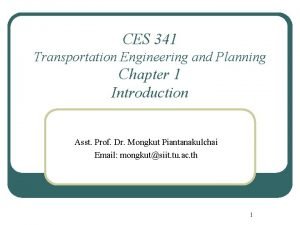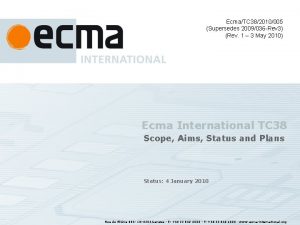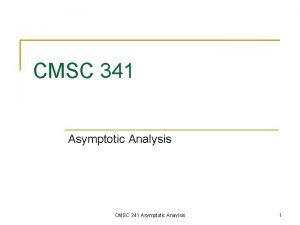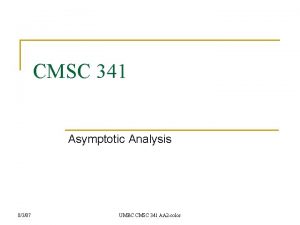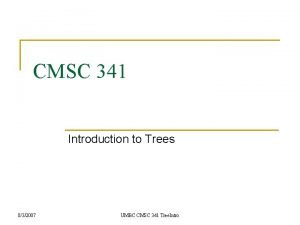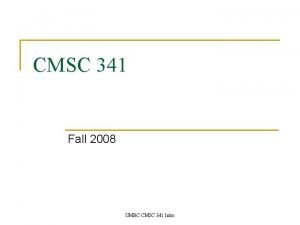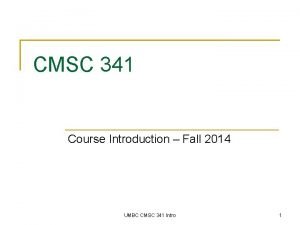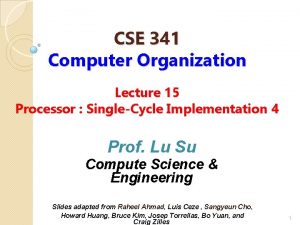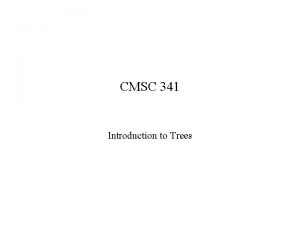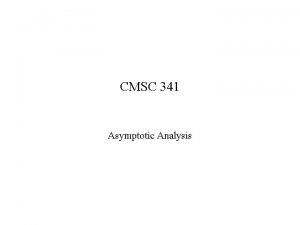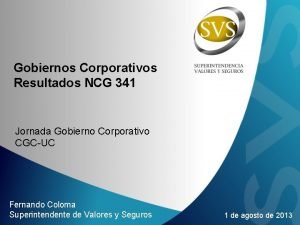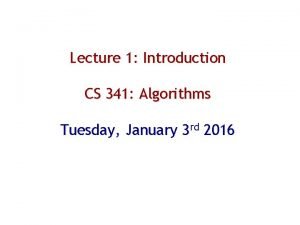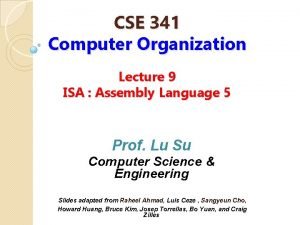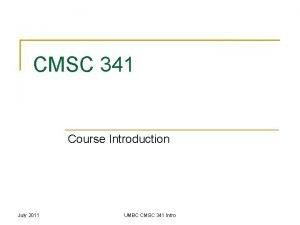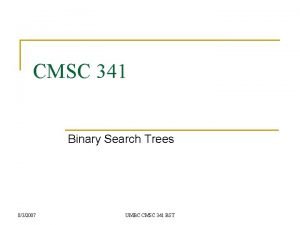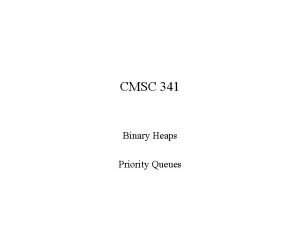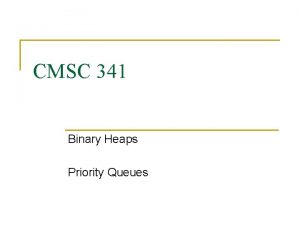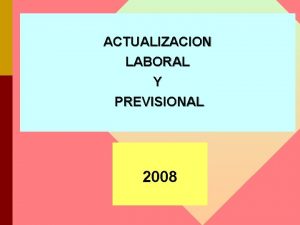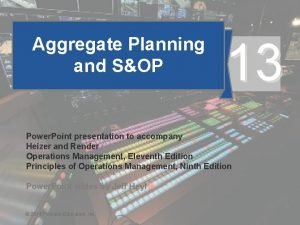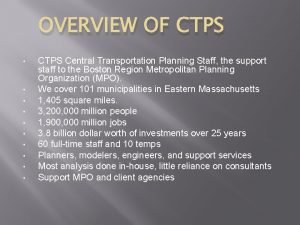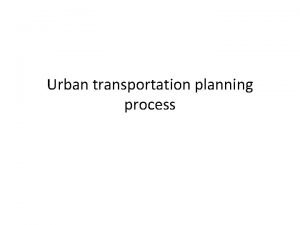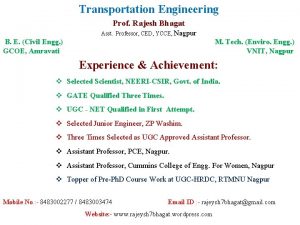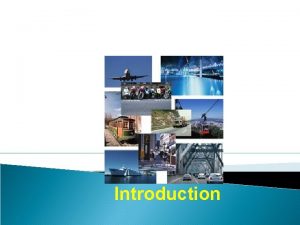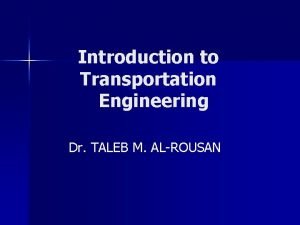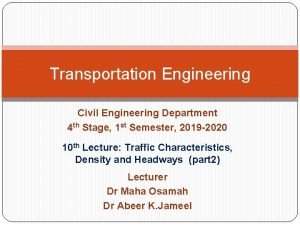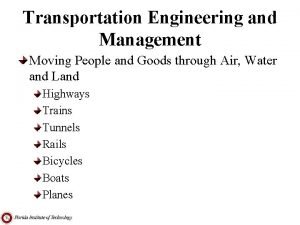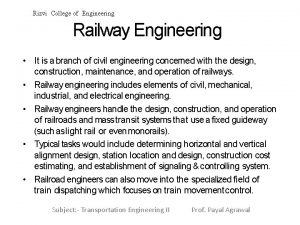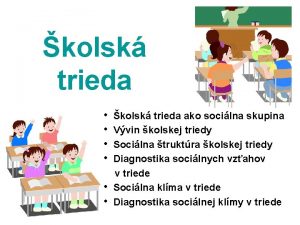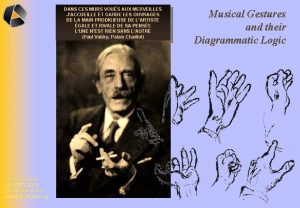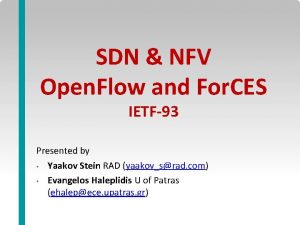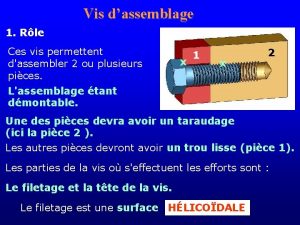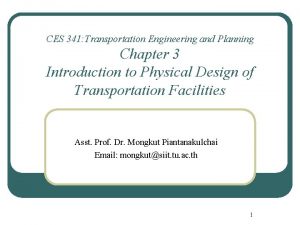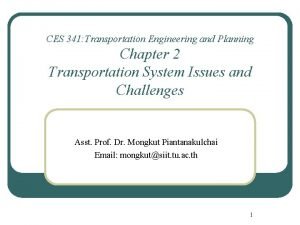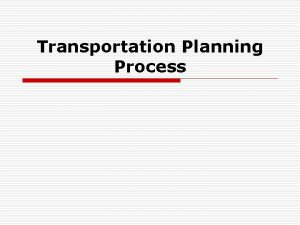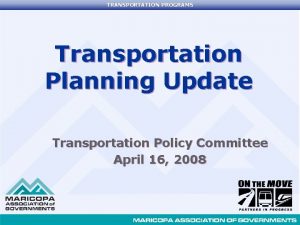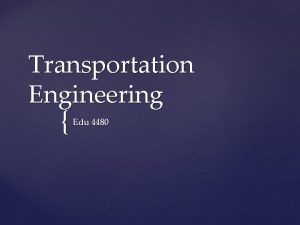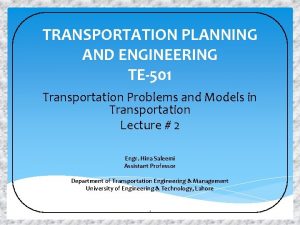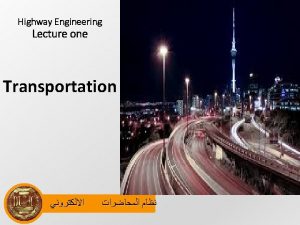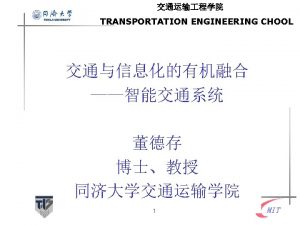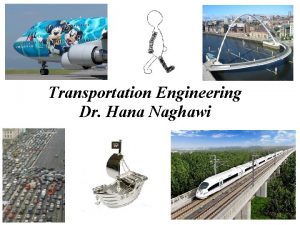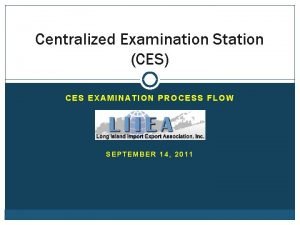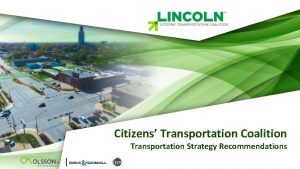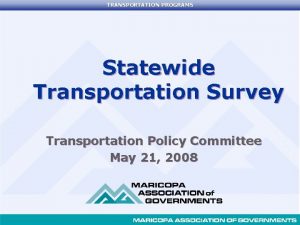CES 341 Transportation Engineering and Planning Chapter 8
















































- Slides: 48

CES 341: Transportation Engineering and Planning Chapter 8 Traffic Analysis Techniques Asst. Prof. Dr. Mongkut Piantanakulchai Email: mongkut@siit. tu. ac. th 1

8. 1 Space-Time Relationships t 2 t 1 Figure 8. 1 Space-time diagram CES 341 Transportation Engineering and Planning Chapter 8: Traffic Analysis Techniques 2

8. 1 Space-Time Relationships t 2 t 1 Note: Assume vehicle’s length is negligible CES 341 Transportation Engineering and Planning Chapter 8: Traffic Analysis Techniques 3

8. 1. 1 Direct Graphical Solution Fig. 8. 2 Location and size of double-track sections • Determine number and location of double-track sections, and the minimum length required for such sections in order for trains running as much as 2 min behind schedule to pass one another without delay CES 341 Transportation Engineering and Planning Chapter 8: Traffic Analysis Techniques ØTransit system ØSingle track 15 km long ØTrain 10 min interval dispatched from each end (W-E) Ø 5 min layovers ØNeglect stop time at stations ØUniform speed 45 km/h both directions 4

8. 1. 1 Direct Graphical Solution Fig. 8. 3 Train dispatch problem 1) Determine earliest time the W-bound train can arrive at the W end of the line 2) Determine the latest dispatch time (after 1: 00 p. m. ) that will allow the W-bound train to reach its destination without unnecessary delay CES 341 Transportation Engineering and Planning Chapter 8: Traffic Analysis Techniques ØRail line 90 km long Ø 7. 5 km long doubletrack section located between 60 -67. 5 km from W end ØA train leaves W end at 1: 00 p. m. and travel E at constant speed of 45 km/h ØThe second train leaves from the E end at 1: 30 p. m. and may travel at any speed up to 90 km/h 5

8. 1. 2 Development of Analytical Solutions l l Complicated space-time problems Space-time diagrams are used to derive analytical solutions CES 341 Transportation Engineering and Planning Chapter 8: Traffic Analysis Techniques 6

Example: Runway Capacity Analysis Fig. 8. 4 Time separation at runway threshold, vi ≤ vj CES 341 Transportation Engineering and Planning Fig. 8. 5 Time separation at runway threshold, vi ≥ vj Chapter 8: Traffic Analysis Techniques 7

Example: Runway Capacity Analysis Weighted average of interarrival time Capacity is expressed by (10. 1) (10. 2) where pij = probability of arrival pair i-j If arrivals are independent (10. 3) Note: Assume arrivals only, no departures More details in CES 446 Port and Airport Engineering CES 341 Transportation Engineering and Planning Chapter 8: Traffic Analysis Techniques 8

8. 1. 3 Development of Simulation Models l l l More complicated problems Space-time diagrams are used to develop simulation models Behavior of system in a step-by-step manner CES 341 Transportation Engineering and Planning Chapter 8: Traffic Analysis Techniques 9

Example: Block Signal Control System for Rail Line l l Objective: To protect train collisions and other hazards such as broken rails System consists of • • • l System of blocks and aspects (combination of signal lights) Electronically insulated section of tracks = blocks Train detection system: to determine if a train is in a particular block (the block is occupied) Signal system (warn or control) CES 341 Transportation Engineering and Planning Chapter 8: Traffic Analysis Techniques 10

Example: Block Signal Control System for Rail Line Fig. 8. 6 Block signal control systems CES 341 Transportation Engineering and Planning Chapter 8: Traffic Analysis Techniques 11

Example: Block Signal Control System l l 0. 75 km long blocks Three-block, four aspect system • RR –stop and proceed at 7. 5 km/h prepared to stop • RY – proceed at 30 km/h, prepare to stop at next • • signal GY – proceed at 60 km/h GG – proceed at full speed CES 341 Transportation Engineering and Planning Chapter 8: Traffic Analysis Techniques 12

Example: Block Signal Control System • • • A train traveling at 45 km/h, passes a point A, which is located at a block boundary, at 11: 00 a. m. Five min and 30 s later, a second train passes this point traveling at 90 km/h in the same direction Both trains are 0. 375 km long Describe the motion of the second train, determine the time that the rear of second train passes point B, located 4. 875 km beyond point A CES 341 Transportation Engineering and Planning Chapter 8: Traffic Analysis Techniques 13

Time-space diagram of the first train CES 341 Transportation Engineering and Planning Chapter 8: Traffic Analysis Techniques 14

Signal indication after the first train CES 341 Transportation Engineering and Planning Chapter 8: Traffic Analysis Techniques 15

Trajectory of the second train according to block signals CES 341 Transportation Engineering and Planning Chapter 8: Traffic Analysis Techniques 16

Trajectory of the second train (front) according to block signals CES 341 Transportation Engineering and Planning Chapter 8: Traffic Analysis Techniques 17

Trajectory of the second train (front&rear) according to block signals CES 341 Transportation Engineering and Planning Chapter 8: Traffic Analysis Techniques 18

8. 14 Non-trajectory Space-Time Diagrams l l Display information about traffic states (speed, flow rate, density) as well as vehicle trajectories Contour diagram can be used to display region with similar traffic state values CES 341 Transportation Engineering and Planning Chapter 8: Traffic Analysis Techniques 19

8. 14 Non-trajectory Space-Time Diagrams Figure 8. 11 Speed contours CES 341 Transportation Engineering and Planning Chapter 8: Traffic Analysis Techniques 20

8. 2 Queuing Analysis Figure 8. 12 Queuing System CES 341 Transportation Engineering and Planning Chapter 8: Traffic Analysis Techniques 21

8. 2. 1 Queuing Theory Fundamentals Figure 8. 13 Arrival function for airport runway CES 341 Transportation Engineering and Planning Figure 8. 14 Arrival and departure functions for airport runway Chapter 8: Traffic Analysis Techniques 22

8. 2. 1 Queuing Theory Fundamentals Figure 8. 14 Queuing diagram features CES 341 Transportation Engineering and Planning Figure 8. 14 Queuing diagram, smooth curve approximation Chapter 8: Traffic Analysis Techniques 23

8. 2. 2 Queue Discipline l l First-in, first-out (FIFO( Last-in, first-out (LIFO( Random service Priority service CES 341 Transportation Engineering and Planning Chapter 8: Traffic Analysis Techniques 24

Relationship of Delay (w(t)) and Queue Length (Q(t)) of Individual at Time t W(t) = Waiting time (Delay) of an individual at time t Q(t) = Queue length at time t CES 341 Transportation Engineering and Planning Chapter 8: Traffic Analysis Techniques 25

8. 2. 3 Stochastic Queuing Models l Deterministic queuing models – arrival and service rate are deterministic (known as some function) l Stochastic queuing models • constant long term arrival and service rates • short-term random fluctuations around the average rates • arrival rate may exceed service rate for short time intervals and queues will form CES 341 Transportation Engineering and Planning Chapter 8: Traffic Analysis Techniques 26

Stochastic Queuing Models l M/D/1 One Channel Arrivals Exponentially Distributed Service Deterministic (No random variation) Inter-arrival times follow Negative Exponential Distribution l M/M/1 CES 341 Transportation Engineering and Planning Chapter 8: Traffic Analysis Techniques 27

M/D/1 CES 341 Transportation Engineering and Planning Chapter 8: Traffic Analysis Techniques 28

M/M/1 CES 341 Transportation Engineering and Planning Chapter 8: Traffic Analysis Techniques 29

General relationships CES 341 Transportation Engineering and Planning Chapter 8: Traffic Analysis Techniques 30

8. 2. 4 Transportation Applications of Queuing Theory Server opens after arrivals begin Arrival rate temporary exceeds constant service rate Service rate varies Server temporarily shut down CES 341 Transportation Engineering and Planning Chapter 8: Traffic Analysis Techniques 31

8. 2. 5 Queue Density, Storage, and Spillback l l l Density (vehicles per unit distance) Occupancy – fraction of time vehicles are over the detector Objectives of studying queue density • Locating queues and bottlenecks in traffic • Determine the length of the queue and space needed for queue storage, control the queue spillback to upstream section CES 341 Transportation Engineering and Planning Chapter 8: Traffic Analysis Techniques 32

Example Problem 8. 1 l l l Morning peak traffic upstream of a toll booth is given in the table The toll plaza consists of three booths, each of which can handle an average of one vehicle every 6 s. Using queuing diagram, determine the maximum queue, the longest delay to an individual vehicle, and the total delay CES 341 Transportation Engineering and Planning Chapter 8: Traffic Analysis Techniques 33

Example Problem 8. 1 Time period 10 min volume Cumulative volume 7: 00 -7: 10 200 7: 10 -7: 20 400 600 7: 20 -7: 30 500 1100 7: 30 -7: 40 250 1350 7: 40 -7: 50 200 1550 7: 50 -8: 00 150 1700 CES 341 Transportation Engineering and Planning Chapter 8: Traffic Analysis Techniques 34

Cumulative volume, A(t) 300 veh/min, D(t)>A(t) {Show A(t), No queues} 8 -21 CES 341 Transportation Engineering and Planning Chapter 8: Traffic Analysis Techniques 35

8. 3 Network Analysis l Network • Nodes : Usually points of facilities intersect • Origins or destinations of trips (source or sink nodes) • Decision points • Links : Usually road or railway segments l Link characteristics • Link costs: Distance, travel time, generalized costs (weighted sum of several costs) CES 341 Transportation Engineering and Planning Chapter 8: Traffic Analysis Techniques 36

Network Elements 8 -23 CES 341 Transportation Engineering and Planning Chapter 8: Traffic Analysis Techniques 37

Example network Minimum path algorithm, step 1 8 -25 CES 341 Transportation Engineering and Planning Chapter 8: Traffic Analysis Techniques 38

Minimum path algorithm, step 2 8 -26 CES 341 Transportation Engineering and Planning Chapter 8: Traffic Analysis Techniques 39

Minimum path algorithm, step 3 8 -27 CES 341 Transportation Engineering and Planning Chapter 8: Traffic Analysis Techniques 40

Minimum path algorithm, step 4 8 -28 CES 341 Transportation Engineering and Planning Chapter 8: Traffic Analysis Techniques 41

Minimum path algorithm, step 5 8 -29 CES 341 Transportation Engineering and Planning Chapter 8: Traffic Analysis Techniques 42

Minimum path algorithm, step 6 8 -30 CES 341 Transportation Engineering and Planning Chapter 8: Traffic Analysis Techniques 43

Table 8. 1 Link-cost array Node 1 2 3 4 5 6 1 -1 8 -1 2 -1 -1 CES 341 Transportation Engineering and Planning 2 8 -1 -1 -1 2 -1 3 -1 4 -1 -1 -1 3 4 2 -1 -1 -1 3 -1 Chapter 8: Traffic Analysis Techniques 5 -1 2 -1 -1 -1 10 6 -1 -1 3 -1 10 -1 44

8 -31 CES 341 Transportation Engineering and Planning Chapter 8: Traffic Analysis Techniques 45

Copyright © The Mc. Graw-Hill Companies, Inc. Permission required for reproduction or display. 8 -32 CES 341 Transportation Engineering and Planning Chapter 8: Traffic Analysis Techniques 46

Copyright © The Mc. Graw-Hill Companies, Inc. Permission required for reproduction or display. 8 -33 CES 341 Transportation Engineering and Planning Chapter 8: Traffic Analysis Techniques 47

Copyright © The Mc. Graw-Hill Companies, Inc. Permission required for reproduction or display. 8 -34 CES 341 Transportation Engineering and Planning Chapter 8: Traffic Analysis Techniques 48
 341 ces
341 ces Sda hymn 341
Sda hymn 341 Ecma-341
Ecma-341 Cmsc 341
Cmsc 341 Cmsc 341
Cmsc 341 Round 625 to the nearest hundred
Round 625 to the nearest hundred Komax gamma 333 pc manual
Komax gamma 333 pc manual Cmsc 341
Cmsc 341 Cmsc 341 umbc
Cmsc 341 umbc Cmsc 341
Cmsc 341 Jump instruction
Jump instruction Cmsc 341
Cmsc 341 Cmsc 341
Cmsc 341 Acer predator xr341ck
Acer predator xr341ck 341 hymnes et louanges
341 hymnes et louanges Mgmt 341
Mgmt 341 Ncg 341
Ncg 341 Cs350 uwaterloo
Cs350 uwaterloo Isa computer organization
Isa computer organization Cmsc 203 umbc
Cmsc 203 umbc Cmsc 341 umbc
Cmsc 341 umbc Cmsc 341
Cmsc 341 Cmsc 341
Cmsc 341 Actualizacion 341
Actualizacion 341 Aggregate planning definition
Aggregate planning definition Central transportation planning staff
Central transportation planning staff Urban transportation act of 1964
Urban transportation act of 1964 Transportation engineering
Transportation engineering About the bed
About the bed Transportation engineering meaning
Transportation engineering meaning Transportation engineering definition
Transportation engineering definition Transportation engineering
Transportation engineering Transportation engineering
Transportation engineering Coning of rails
Coning of rails Cambridge engineering selector
Cambridge engineering selector Dotazník ces na diagnostikovanie klímy v triede
Dotazník ces na diagnostikovanie klímy v triede Qui sont ces gens au radieux visage
Qui sont ces gens au radieux visage Ces production function is developed by
Ces production function is developed by Función ces
Función ces Demonstrative adjectives french examples
Demonstrative adjectives french examples Din 8996
Din 8996 Progetie
Progetie Plan de interventie personalizat tulburari de limbaj
Plan de interventie personalizat tulburari de limbaj Open flow protocol
Open flow protocol Iso 14020
Iso 14020 Ces battery box 3f home premium cena
Ces battery box 3f home premium cena Ces enfants d'ailleurs
Ces enfants d'ailleurs Plan de interventie personalizat ces liceu
Plan de interventie personalizat ces liceu Pessoas vis
Pessoas vis
